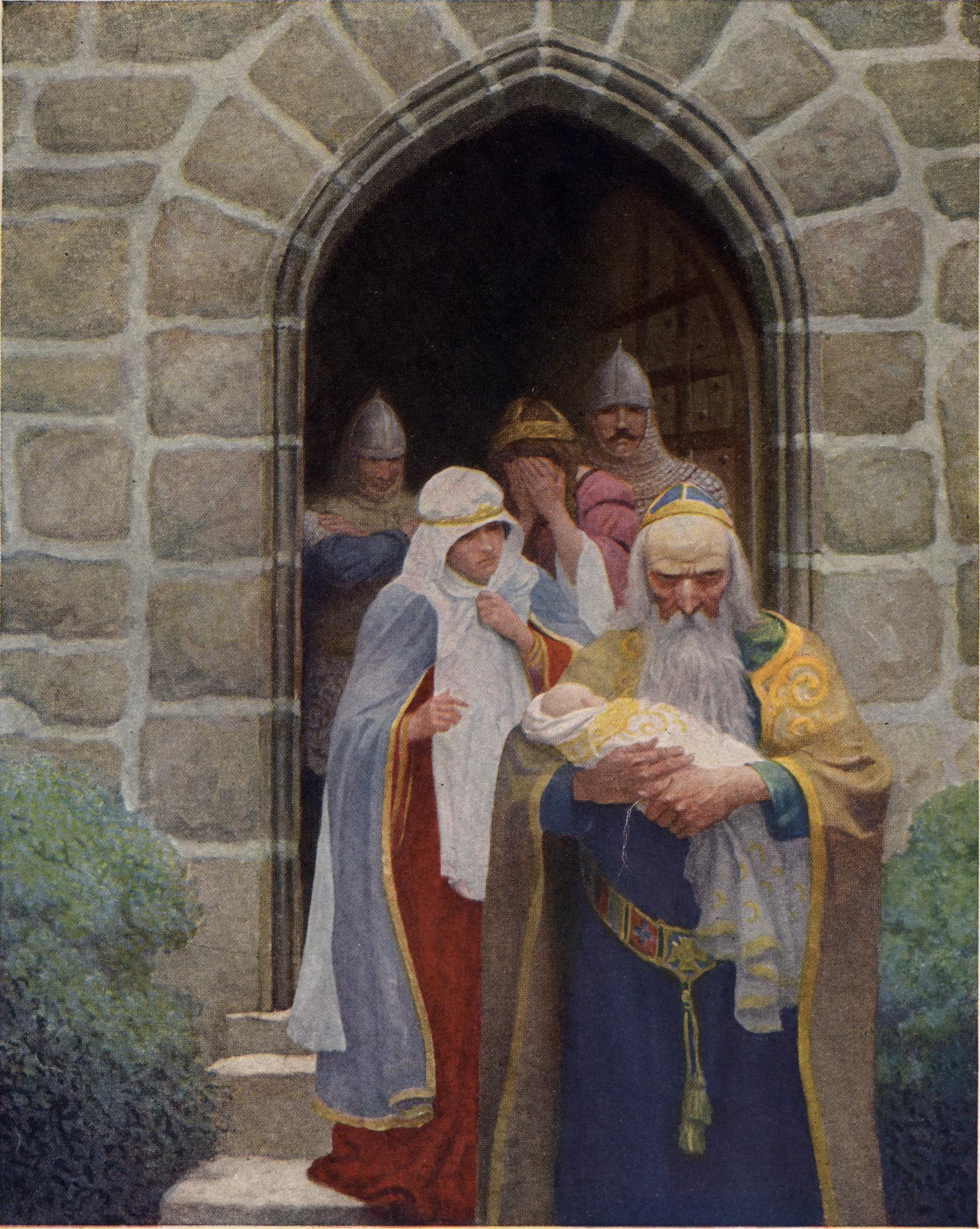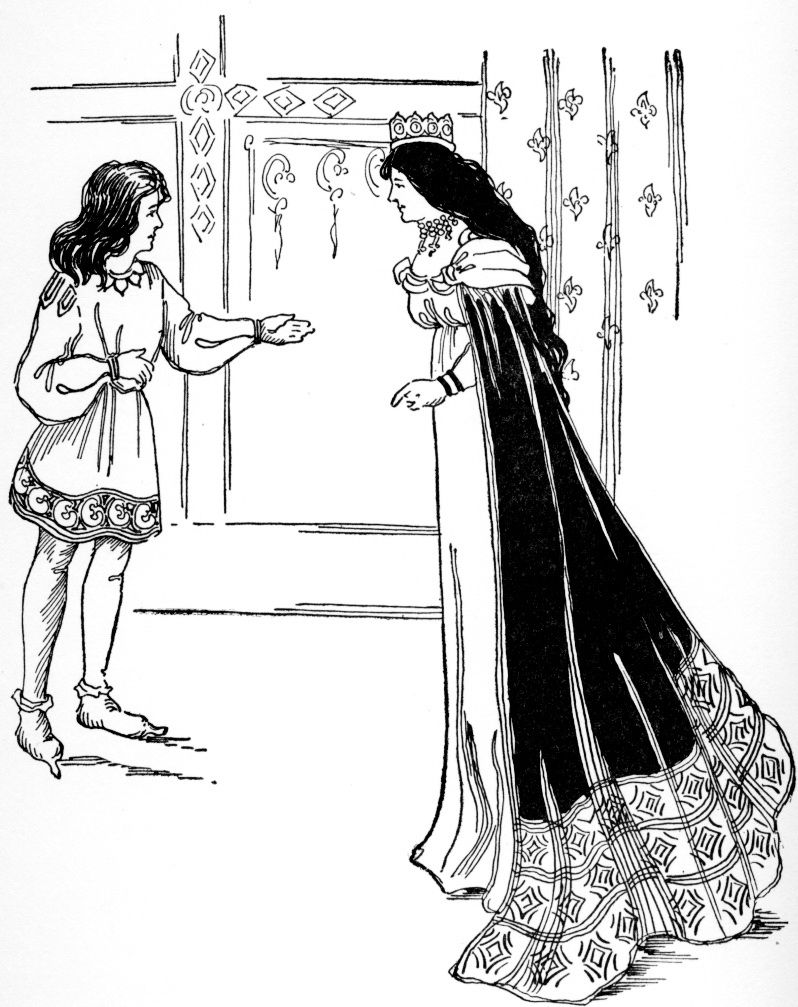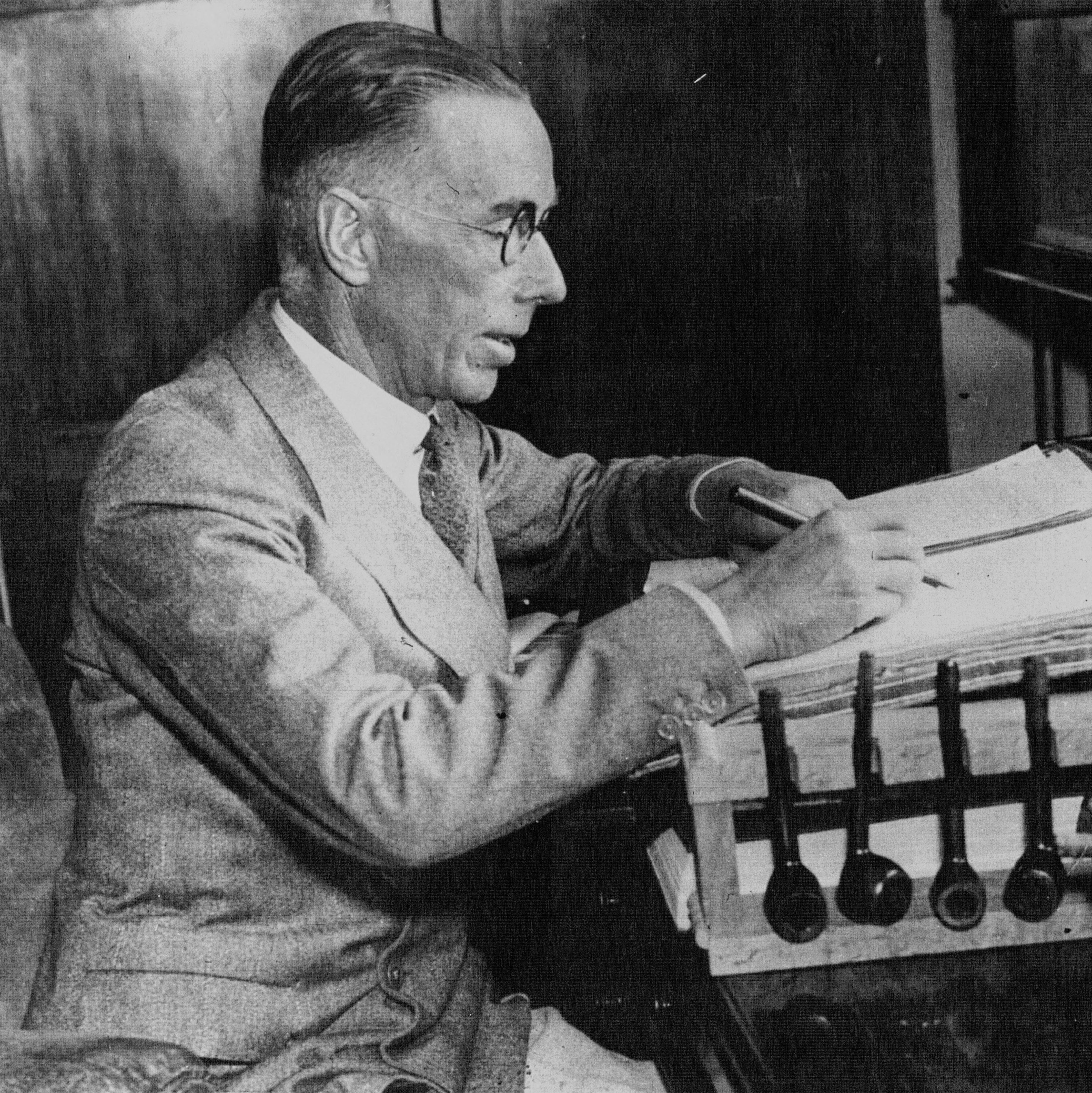|
Igraine
In the Matter of Britain, Igraine () is the mother of King Arthur. Igraine is also known in Latin as Igerna, in Welsh as Eigr (Middle Welsh Eigyr), in French as Ygraine (Old French Ygerne or Igerne), in ''Le Morte d'Arthur'' as Ygrayne—often modernised as Igraine or Igreine—and in ''Parzival'' as Arnive. She becomes the wife of Uther Pendragon, after the death of her first husband, Gorlois. Geoffrey of Monmouth and Welsh tradition In Geoffrey of Monmouth's ''Historia Regum Britanniae'', Igerna enters the story as the wife of Gorlois, Duke of Cornwall. In Thomas Malory's ''Le Morte d'Arthur'', her daughters by Gorlois are Elaine, Morgause and Morgan le Fay. In the ''Brut Tysilio'', Cador of Cornwall is their son. John Hardyng's ''Chronicle'' calls Cador Arthur's brother "of his mother's syde". Geoffrey describes her as one "whose beauty surpassed that of all the women of Britain." King Uther Pendragon falls in love with her and attempts to force his attentions on he ... [...More Info...] [...Related Items...] OR: [Wikipedia] [Google] [Baidu] |
Gorlois
In Arthurian legend, Gorlois ( cy, Gwrlais) of Tintagel, Duke of Cornwall, is the first husband of Igraine, whose second husband is Uther Pendragon. Gorlois's name first appears in Geoffrey of Monmouth's ''Historia Regum Britanniae'' (). A vassal of Ambrosius Aurelianus, his arrival at the Battle of Kaerconan ensures the defeat of Hengist.Bruce, Christopher W., ''The Arthurian Name Dictionary'', Taylor & Francis, 1999 In 's '' |
Uther Pendragon
Uther Pendragon (Brittonic) (; cy, Ythyr Ben Dragwn, Uthyr Pendragon, Uthyr Bendragon), also known as King Uther, was a legendary King of the Britons in sub-Roman Britain (c. 6th century). Uther was also the father of King Arthur. A few minor references to Uther appear in Old Welsh poems, but his biography was first written down in the 12th century by Geoffrey of Monmouth in his ''Historia Regum Britanniae'' (''History of the Kings of Britain''), and Geoffrey's account of the character was used in most later versions. He is a fairly ambiguous individual throughout the literature, but is described as a strong king and a defender of his people. According to Arthurian legend, Merlin magically disguises Uther to look like his enemy Gorlois, enabling Uther to sleep with Gorlois' wife Lady Igraine. Thus Arthur, "the once and future king", is an illegitimate child (though later legend, as found in Malory, emphasises that the conception occurred after Gorlois's death and that h ... [...More Info...] [...Related Items...] OR: [Wikipedia] [Google] [Baidu] |
Morgan Le Fay
Morgan le Fay (, meaning 'Morgan the Fairy'), alternatively known as Morgan[n]a, Morgain[a/e], Morg[a]ne, Morgant[e], Morge[i]n, and Morgue[in] among other names and spellings ( cy, Morgên y Dylwythen Deg, kw, Morgen an Spyrys), is a powerful and ambiguous Magician (fantasy), enchantress from the legend of King Arthur, in which most often she and he are siblings. Early appearances of Morgan in Arthurian literature do not elaborate her character beyond her role as a goddess, a fairy , fay, a Witchcraft , witch, or a sorceress, generally benevolent and connected to Arthur as his magical saviour and protector. Her prominence increased as legends developed over time, as did her moral ambivalence, and in some texts there is an evolutionary transformation of her to an antagonist, particularly as portrayed in cyclical prose such as the ''Lancelot-Grail'' and the Post-Vulgate Cycle. A significant aspect in many of Morgan's Middle Ages, medieval and later iterations is the unpredictab ... [...More Info...] [...Related Items...] OR: [Wikipedia] [Google] [Baidu] |
Tintagel Castle
Tintagel Castle ( kw, Dintagel) is a medieval fortification located on the peninsula of Tintagel Island adjacent to the village of Tintagel (Trevena), North Cornwall in the United Kingdom. The site was possibly occupied in the Romano-British period, as an array of artefacts dating from this period have been found on the peninsula, but as yet no Roman-era structure has been proven to have existed there. It was settled during the early medieval period, when it was probably one of the seasonal residences of the regional king of Dumnonia. A castle was built on the site by Richard, 1st Earl of Cornwall in the 13th century, during the High Middle Ages. It later fell into disrepair and ruin. Archaeological investigation into the site began in the 19th century as it became a tourist attraction, with visitors coming to see the ruins of Richard's castle. In the 1930s, excavations revealed significant traces of a much earlier high status settlement, which had trading links with the Mediter ... [...More Info...] [...Related Items...] OR: [Wikipedia] [Google] [Baidu] |
List Of Legendary Rulers Of Cornwall
"Duke of Cornwall" appears as a title in pseudo-historical authors such as Geoffrey of Monmouth. The list is patchy and not every succession was unbroken. Indeed, Monmouth repeatedly introduces Dukes of Cornwall only to promote them to the Kingship of the Britons and thus put an end to their line as (merely) dukes. As adjuncts or supporting roles to the kings of the Britons, the legendary dukes of Cornwall are considered part of the vast Matter of Britain, and can also be found in other stories, such as ''Culhwch and Olwen'', the Prose ''Tristan'', ''Havelok the Dane'', and ''Gesta Herewardi''. Antiquaries such as Richard Carew ('' Survey of Cornwall'', 1602) and John Williams (the ''Book of Baglan'', 1600–1607) also provide lists of legendary rulers of Cornwall, often combining the above with other sources. As a result, these lists are more often thought of as a conglomeration of various Celtic rulers, Celtic warlords, and mythical heroes. If the lists of kings of Britain ar ... [...More Info...] [...Related Items...] OR: [Wikipedia] [Google] [Baidu] |
Cador
Cador (''Latin'': Cadorius) was a legendary Duke of Cornwall, known chiefly through Geoffrey of Monmouth's pseudohistorical ''Historia Regum Britanniae'' and previous manuscript sources such as the Life of Carantoc. Early sources present Cador as a relative of King Arthur, though the details of their kinship are usually left unspecified. Historicity Many stories involving Arthurian figures were likely passed down orally, which has led to many different interpretations and versions of the people and characters mentioned. Scholars generally question the historical accuracy of these tales. Evidence shows that people like Arthur may have been real historical figures. However, most of the deeds of Arthur have been discredited. Because of this, the people he is associated with and their stories could be solely a part of the orally passed down myths of Arthur's legacy and not true history. One of these figures was Cado, a successor of Geraint ab Erbin and a close associate of Art ... [...More Info...] [...Related Items...] OR: [Wikipedia] [Google] [Baidu] |
Morgause
The Queen of Orkney, today best known as Morgause and also known as Morgawse and other spellings and names, is a character in later Arthurian traditions. In some versions of the legend, including the seminal text ''Le Morte d'Arthur'', she is the mother of Gawain and Mordred, both key players in the story of King Arthur and his downfall. Mordred is the offspring of Arthur's accidental incest with Morgause, the king's estranged half-sister. She is furthermore a sister of Morgan le Fay and the wife of King Lot of Orkney, as well as the mother of Gareth, Agravain, and Gaheris, the last of whom murders her. Earlier counterparts The corresponding character of Arthur's sister in Geoffrey of Monmouth's 12th-century Latin chronicle ''Historia Regum Britanniae'' is named Anna, and is depicted as a daughter of Uther Pendragon and Igraine. In Wolfram von Eschenbach's ''Parzival'', Anna is replaced by Sangive, whom the poet Der Pleier calls Seife. They are usually cast in the role of Lo ... [...More Info...] [...Related Items...] OR: [Wikipedia] [Google] [Baidu] |
Le Morte D'Arthur
' (originally written as '; inaccurate Middle French for "The Death of Arthur") is a 15th-century Middle English prose reworking by Sir Thomas Malory of tales about the legendary King Arthur, Guinevere, Lancelot, Merlin and the Knights of the Round Table, along with their respective folklore. In order to tell a "complete" story of Arthur from his conception to his death, Malory compiled, rearranged, interpreted and modified material from various French and English sources. Today, this is one of the best-known works of Arthurian literature. Many authors since the 19th-century revival of the legend have used Malory as their principal source. Apparently written in prison at the end of the medieval English era, ''Le Morte d'Arthur'' was completed by Malory around 1470 and was first published in a printed edition in 1485 by William Caxton. Until the discovery of the Winchester Manuscript in 1934, the 1485 edition was considered the earliest known text of ''Le Morte d'Arthur'' and that ... [...More Info...] [...Related Items...] OR: [Wikipedia] [Google] [Baidu] |
King Arthur
King Arthur ( cy, Brenin Arthur, kw, Arthur Gernow, br, Roue Arzhur) is a legendary king of Britain, and a central figure in the medieval literary tradition known as the Matter of Britain. In the earliest traditions, Arthur appears as a leader of the post-Roman Britons in battles against Saxon invaders of Britain in the late 5th and early 6th centuries. He appears in two early medieval historical sources, the ''Annales Cambriae'' and the ''Historia Brittonum'', but these date to 300 years after he is supposed to have lived, and most historians who study the period do not consider him a historical figure.Tom Shippey, "So Much Smoke", ''review'' of , ''London Review of Books'', 40:24:23 (20 December 2018) His name also occurs in early Welsh poetic sources such as ''Y Gododdin''. The character developed through Welsh mythology, appearing either as a great warrior defending Britain from human and supernatural enemies or as a magical figure of folklore, sometimes associated wi ... [...More Info...] [...Related Items...] OR: [Wikipedia] [Google] [Baidu] |
Warwick Deeping
George Warwick Deeping (28 May 1877 – 20 April 1950) was an English novelist and short story writer, whose best-known novel was '' Sorrell and Son'' (1925). Life Born in Southend-on-Sea, Essex, into a family of physicians, Warwick Deeping was educated at Merchant Taylors' School. He proceeded to Trinity College, Cambridge, to study medicine and science (receiving his MA in March 1902), then went to Middlesex Hospital to finish his medical training. During the First World War, he served in the Royal Army Medical Corps. Deeping later gave up his job as a physician to become a full-time writer. He married Phyllis Maude Merrill and lived for the rest of his life in "Eastlands" on Brooklands Road, Weybridge, Surrey. He was one of the best-selling authors of the 1920s and 1930s, with seven of his novels making the best-seller list. Deeping was a prolific writer of short stories, which appeared in such British magazines as ''Cassell's'', ''The Story-Teller'', and ''The Strand'' ... [...More Info...] [...Related Items...] OR: [Wikipedia] [Google] [Baidu] |
Merlin
Merlin ( cy, Myrddin, kw, Marzhin, br, Merzhin) is a mythical figure prominently featured in the legend of King Arthur and best known as a mage, with several other main roles. His usual depiction, based on an amalgamation of historic and legendary figures, was introduced by the 12th-century British author Geoffrey of Monmouth. It is believed that Geoffrey combined earlier tales of Myrddin and Ambrosius, two legendary Briton prophets with no connection to Arthur, to form the composite figure called Merlinus Ambrosius ( cy, Myrddin Emrys, br, Merzhin Ambroaz). Geoffrey's rendering of the character became immediately popular, especially in Wales. Later writers in France and elsewhere expanded the account to produce a fuller image, creating one of the most important figures in the imagination and literature of the Middle Ages. Merlin's traditional biography casts him as an often-mad being born of a mortal woman, sired by an incubus, from whom he inherits his supernatural powe ... [...More Info...] [...Related Items...] OR: [Wikipedia] [Google] [Baidu] |
Historia Regum Britanniae
''Historia regum Britanniae'' (''The History of the Kings of Britain''), originally called ''De gestis Britonum'' (''On the Deeds of the Britons''), is a pseudohistorical account of British history, written around 1136 by Geoffrey of Monmouth. It chronicles the lives of the kings of the Britons over the course of two thousand years, beginning with the Trojans founding the British nation and continuing until the Anglo-Saxons assumed control of much of Britain around the 7th century. It is one of the central pieces of the Matter of Britain. Although taken as historical well into the 16th century, it is now considered to have no value as history. When events described, such as Julius Caesar's invasions of Britain, can be corroborated from contemporary histories, Geoffrey's account can be seen to be wildly inaccurate. It remains, however, a valuable piece of medieval literature, which contains the earliest known version of the story of King Lear and his three daughters, and helped ... [...More Info...] [...Related Items...] OR: [Wikipedia] [Google] [Baidu] |


_Uthr_Bendragon.jpg)


.jpg)




